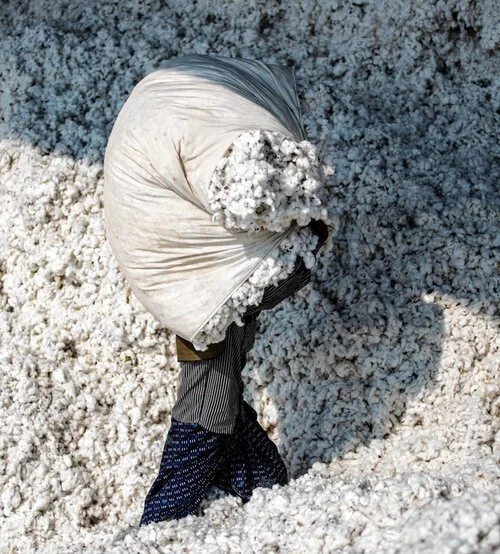Cotton Diaries: From Seed to Shelf
Photo credit: Cotton Diaries
Cotton as a system
The fashion industry does not operate in a vacuum. It is an industry that is dependent on and interconnected with other industries including food and agriculture. Cotton, the most widely used natural fiber in the fashion and home textile industry, is a prime example of this connection.
Being grown in 86 countries across the world and notorious for its fragmented and complex supply network, the importance of thinking of cotton as a system, and not merely from the perspective of transactions along a supply chain, is paramount to improving how cotton is cultivated and for ensuring the people who grow it are paid and treated fairly. On this episode of Unspun, Marzia Lanfranchi joins Danielle, Lauren, and Catherine for a conversation about how we can and should break the silos of the fashion industry focusing specifically on the global cotton system and the prioritization of the people on the ground—the farmers themselves.
Learning firsthand
Marzia Lanfranchi, independent sustainable fashion consultant and Founder and Director of Cotton Diaries has spent the past several years on the ground understanding various aspects of the cotton value chain, from seed to shelf. Driven by curiosity and restlessness, Marzia wanted to understand the system of cotton and has done so by working on cotton farms and interviewing people throughout the chain, including growers, agronomists, seed breeders, and others. She found inspiration through these experiences and in witnessing various solutions implemented by changemakers.
What is the responsibility of brands?
“WE HAVE THIS SYSTEM WHERE WE TAKE ADVANTAGE AND BENEFIT FROM A GLOBAL MARKET BUT THEN WE DON’T GIVE BACK AND CONTRIBUTE TO GLOBAL SOLUTIONS.”
The fashion industry, along with most industries, is based on a system rooted in exponential growth. However, this growth is reserved for brands looking to accumulate wealth and not distribute it equally to others in the value chain which makes this growth possible. Marzia advocates for de-growth, or what she calls redistribution of wealth. She estimates that some cotton farmers don’t break even and some might make a 1% profit margin whereas brands might be making 30%+ margins. Moreover, the economics of cotton are complicated because cotton is a commodity and is often subsidized by governments or even bought by governments. We, therefore, must think not only about the redistribution of wealth but also the redistribution of risk and reward.
Additionally, brands benefit from the complex and fragmented nature of the cotton supply chain. That being said, there are brands that are putting in the work towards understanding and supporting their supply chain communities. For example, Veja has incorporated an agricultural budget into their business model so they can understand the needs of the communities they operate in and better support them. Marzia is calling on brands that have a marketing budget to show how sustainable their cotton is, but not an agricultural budget to understand the sourcing of their cotton in order to reexamine their business models.
“WHAT BRANDS DO WHEN THERE IS A SCANDAL IS THEY REACT, REACT, REACT. WHY? BECAUSE THEY DON’T HAVE VISIBILITY INTO THEIR SUPPLY CHAIN, SO THEY DON’T HAVE A PROACTIVE APPROACH TO THE RISK IN THEIR SUPPLY CHAIN AND IN THEIR SYSTEM AT LARGE.”
When news came out regarding cotton production in the Xinjiang region of China, Marzia saw many people come forward to talk about it without entirely knowing the situation. In general, Marzia explains how when there is a scandal, people and brands are quick to speak out and react. This approach is inevitable considering brands have little visibility into their supply chains and cannot understand the issues that exist. We need real transparency and traceability to allow for a proactive approach and, she explains, 3rd party certifications haven’t been enough to achieve this.
Importance of partnerships
Marzia believes we should change our approach from focusing on exponential growth and instead to focusing on partnerships. Brands are often constantly searching for the cheapest labor and resources rather than building long-term partnerships. The ones who understand the necessity of partnerships are able to address risks and issues in the system proactively. They are the ones that can develop resiliency and grow stronger together.
Going to the source
Having conversations and asking questions are the best ways to truly comprehend the needs and experiences of people all along the supply chain. Marzia found that the people she’s spent time interviewing and learned from are very open to having these conversations. We must take the initiative to go directly to the source and ask the necessary questions to understand the convoluted system of cotton and fashion in general.
As brands are responding to calls for transparency and traceability, they are often missing a simple yet essential component: real, human connections with the people growing cotton. While it can be convenient to rely on global statistics to attempt to understand something as complicated as cotton, they are reductive and don’t generally provide the real picture of what is happening on the ground.
Marzia urges consulting firms and people in the industry to listen to people rather than relying on global averages and statistics.
“I DON’T BELIEVE YOUR PRODUCTS ARE 100% SUSTAINABLE UNTIL YOU KNOW WHERE YOU SOURCE YOUR COTTON AND THE REAL RISKS, THE REAL PROBLEMS, AND WORK ON THESE SOLUTIONS.”

